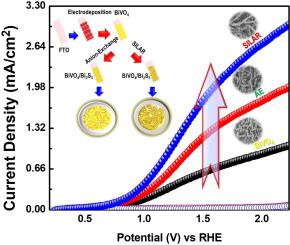Journal of Colloid and Interface Science ( IF 9.4 ) Pub Date : 2020-11-26 , DOI: 10.1016/j.jcis.2020.11.081 Sutripto Majumder , Nguyen Duc Quang , Chunjoong Kim , Dojin Kim

|
Photoelectrochemical water splitting is an environmentally benign way to store solar energy. Properties such as fast charge recombination and poor charge transport rate severely restrict the use of BiVO4 as a photoanode for photoelectrochemical water splitting and many attempts were made to improve the current performance limit of the photoanode. To address these disadvantages, a highly efficient BiVO4/Bi2S3 heterojunction was fabricated applying facial anion-exchange (AE) and successive ionic layer adsorption and reaction (SILAR). The deposition of Bi2S3 on BiVO4 nanoworms by both AE and SILAR was confirmed through morphological, structural, and optical analyses. The morphological analysis indicated that Bi2S3 grown through SILAR has relatively more crystalline-amorphous phase boundaries than Bi2S3 generated using the anion-exchange method. The highest photocurrent density was observed for the SILAR-coated Bi2S3 on BiVO4, which is three times the value of the pristine BiVO4 measured under 1 sun illumination (100 mW cm−2 with Air mass (AM) 1.5 filter) in a 0.5 M Na2SO4 electrolyte at 1.6 V vs. RHE. In addition, the deposition of Bi2S3 through AE results in a twofold higher photocurrent density compared to uncoated BiVO4. The comparison of the two cost-effective AE and SILAR methods to deposit Bi2S3 on BiVO4 showed a negative shift in the flat band Mott-Schottky values, which coincides with the drifted onset potential values of the current density-voltage (J–V) curve. Furthermore, photoelectrochemical impedance spectroscopy (PEIS) analyses and band alignment studies revealed that SILAR-grown Bi2S3 creates an effective heterojunction with BiVO4, which leads to an efficient charge transfer.
中文翻译:

BiVO 4与Bi 2 S 3的阴离子交换和连续离子层吸附及反应辅助涂层,以制备用于增强光电化学水分解的纳米结构光阳极
光电化学水分解是一种存储太阳能的环保方式。快速电荷复合和不良的电荷传输速率等特性严重限制了BiVO 4作为光电化学水分解用光阳极的用途,并进行了许多尝试来改善光阳极的当前性能极限。为了解决这些缺点,使用面部阴离子交换(AE)和连续的离子层吸附和反应(SILAR)制备了高效的BiVO 4 / Bi 2 S 3异质结。Bi 2 S 3在BiVO 4上的沉积通过形态,结构和光学分析证实了AE和SILAR都具有纳米蠕虫。形态分析表明,通过SILAR生长的Bi 2 S 3比使用阴离子交换法生成的Bi 2 S 3具有相对更多的晶体-非晶相边界。在BiVO 4上观察到了SILAR涂层的Bi 2 S 3的最高光电流密度,这是原始BiVO 4在1个阳光照射下测得的值的三倍(100 mW cm -2的空气质量(AM)1.5滤光片)在0.5 M Na 2 SO 4中相对于RHE的电压为1.6V。另外,与未涂覆的BiVO 4相比,通过AE沉积Bi 2 S 3导致光电流密度提高了两倍。将Bi 2 S 3沉积在BiVO 4上的两种具有成本效益的AE和SILAR方法的比较显示,平带Mott-Schottky值出现负向偏移,这与电流密度-电压(J –V)曲线。此外,光电化学阻抗谱(PEIS)分析和能带对准研究表明,SILAR生长的Bi 2 S 3与BiVO 4形成有效的异质结,从而实现高效的电荷转移。











































 京公网安备 11010802027423号
京公网安备 11010802027423号